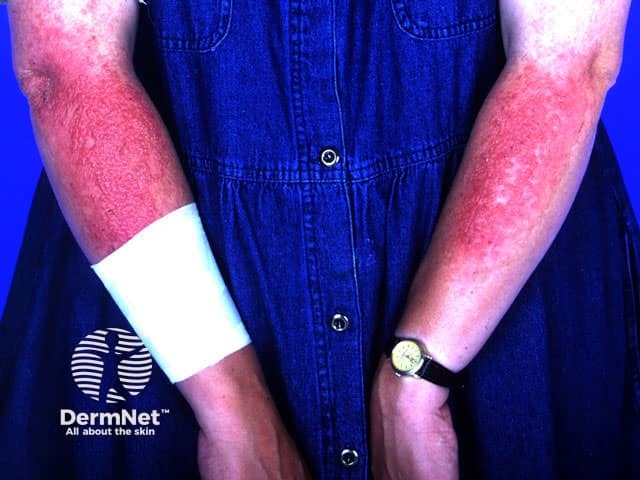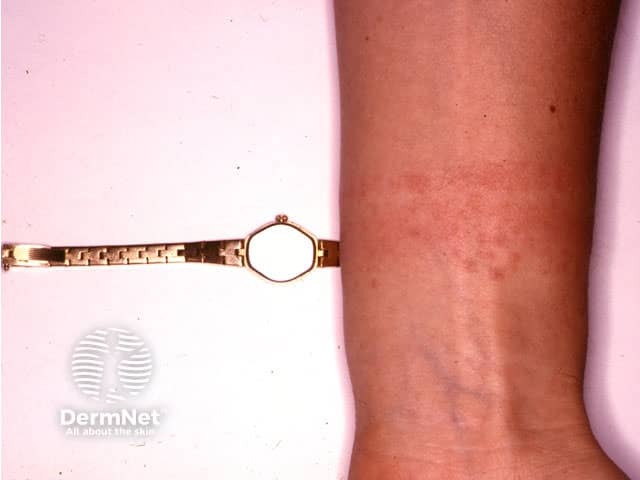Main menu
Common skin conditions

NEWS
Join DermNet PRO
Read more
Quick links
Introduction Demographics Causes Clinical features Differential diagnoses Complications Diagnosis Treatment Outcome
Allergic contact dermatitis is a form of dermatitis/eczema caused by an allergic reaction to a material, called an allergen, in contact with the skin. The allergen is harmless to people that are not allergic to it. Allergic contact dermatitis is also called contact allergy.
Allergic contact dermatitis is common in the general population and in specific employment groups.
Allergic contact dermatitis is a type 4 or delayed hypersensitivity reaction and occurs 48–72 hours after exposure to the allergen. The mechanism involves CD4+ T-lymphocytes, which recognise an antigen on the skin surface, releasing cytokines that activate the immune system and cause the dermatitis. Note:
Allergic contact dermatitis arises some hours after contact with the responsible material. It settles down over some days providing the skin is no longer in contact with the allergen.
Allergic contact dermatitis is generally confined to the site of contact with the allergen, but it may extend outside the contact area or become generalised.
Some typical examples of allergic contact dermatitis include:
There is a very long list of materials that have caused contact allergy in a small number of individuals.

Adhesive plaster reaction

Sunscreen reaction

Watch strap reaction
See more images of allergic contact dermatitis
Specific allergic contact dermatitis images.
Allergic contact dermatitis should be distinguished from:
Allergic contact dermatitis starts as a localised reaction to an allergen in contact with the skin, but severe reactions may generalise due to autoeczematisation and can lead to erythroderma.
Ingestion of a contact allergen may rarely lead to baboon syndrome or generalised systemic contact dermatitis.
Sometimes contact allergy arises only after the skin has been exposed to ultraviolet light. The rash is confined to sun-exposed areas even though the allergen may have been in contact with covered areas. This is called photocontact dermatitis.
Examples of photoallergy include:
Sometimes it is easy to recognise contact allergy and no specific tests are necessary. Taking a very good history including information on the work environment, hobbies, products in use at home and work and sun exposure will enhance the chances of finding a diagnosis. The rash usually (but not always) completely clears up if the allergen is no longer in contact with the skin, but recurs even with slight contact with it again.
The open application test is used to confirm contact allergy to a cosmetic, such as a moisturiser. The product under suspicion is applied several times daily for several days to a small area of sensitive skin. The inner aspect of the upper arm is suitable. Contact allergy is likely if dermatitis arises in the treated area.
Dermatologists will perform patch tests in patients with suspected contact allergy, particularly if the reaction is severe, recurrent or chronic. The tests can identify the specific allergen causing the rash.
Fungal scrapings of skin for microscopy and culture can exclude fungal infection.
Dimethylgloxime test is available to ‘spot test’ if a product contains nickel.
It is important to recognise how you are in contact with the responsible substance so that, where possible, you can avoid it.
Active dermatitis is usually treated with the following:
Contact allergy often persists lifelong so it is essential to identify the allergen and avoid touching it. Dermatitis may recur on re-exposure to the allergen.
Prognosis depends on patient education and compliance in avoiding allergens and appropriate skin care.